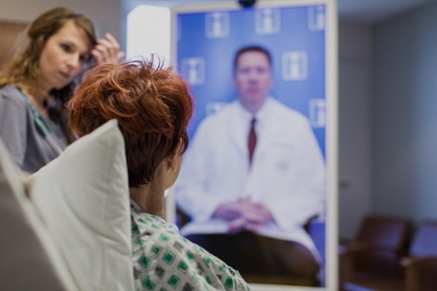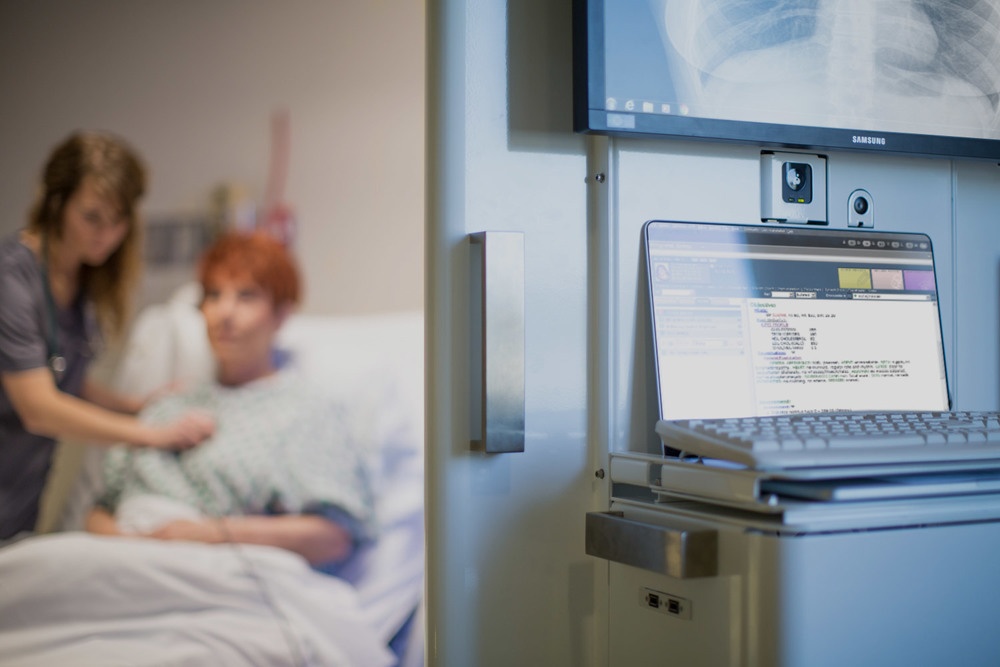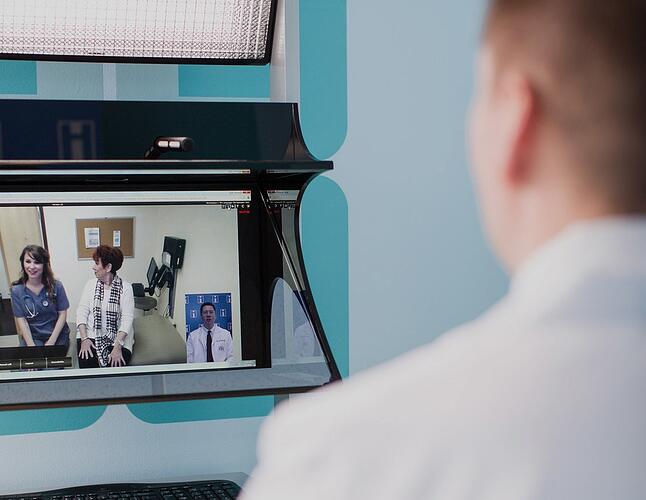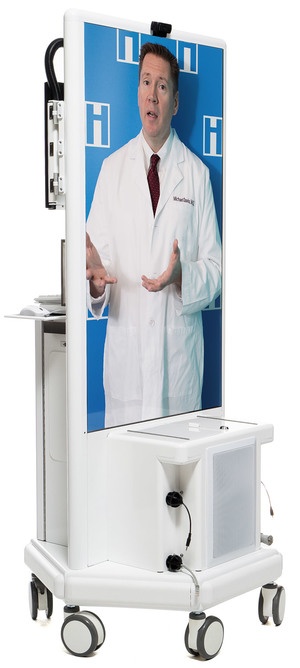Telehealth & Telemedicine
Healthcare is changing.
New technology, Electronic Health Records (EHR), new regulations, shifting patient expectations, and options like retail health care are forcing hospitals and practices to adapt or fail. Today, patients are informed consumers. If you can’t provide them competitive services for their healthcare, they will find a provider that can.
Telehealth, telemedicine and virtual healthcare can help. With the right technology solution, hospitals and providers can improve healthcare outcomes, deliver high-impact services and provide healthcare to patients when and where they need it. Telehealth and telemedicine give providers a competitive edge – an affordable and patient-centric technology solution – in a crowded medical marketplace.


What are Telehealth & Telemedicine?
With telehealth and telemedicine, healthcare providers use telecommunications technology to evaluate, diagnose, treat and provide value to patients over a distance. Even a phone call with your doctor is an example of telehealth in action.
Without technology, healthcare could only be based around in-person visits. Today, as telecommunications technology has improved, virtual health visits, telehealth and telemedicine has become a viable alternative to the often inconvenient or inaccessible in-person visit.
This allows clinicians an alternative healthcare delivery option to ensure their patients have access to quality services. Patients can access their doctor and specialty care more conveniently. They can stay on top of their health even as they navigate a busy schedule and the demands of modern life. Providers can better monitor patient health and deliver healthcare to virtually any location at a moment’s notice.
Telemedicine versus Telehealth: Understanding the Difference
While many will use telehealth, telemedicine and virtual health interchangeably, there is a difference between the terms.
While a simple telehealth phone call is adequate for some healthcare connections, a secure video and audio connection with the capabilities to collect diagnostic information should be used for a telemedicine to ensure compliance with best practices and HIPAA.
A video conference may also work for a quick question or answer session or a check-in, but you can’t expect adequate benefit from an initial specialist consultation using a small screen and low res video. Eye-to-eye contact and a superior doctor and patient connection is only possible through a specialized telemedicine solution.
A close look at HIPAA: The Health Insurance Portability and Accountability Act of 1996 (HIPAA) was a law enacted to create standards and protections for the medical data collected, stored and electronically exchanged. This standard covers hospitals, medical professionals, doctors and doctor’s offices, and any other business where personal medical information is used or stored.
It is important to select the right tool and technology for the treatment and patient needs, including telehealth and telemedicine
Current Applications of Telehealth & Telemedicine
Depending on the technology and the needs of the patient and doctor, there are few limits to how the technology can be applied to healthcare. Many providers and insurers see telemedicine as cost-saving alternative to traditional appointments, or a solution to challenges to accessibility for some patients and providers.
Current applications include, but aren’t limited to:

Follow-Up Visits
Missed appointments are common for follow-up visits. Many patients don’t find them necessary, leading to compromised patient health outcomes and increased readmission rates. Telemedicine makes the follow-up process not only more efficient and convenient, but it can also improve the overall delivery of healthcare.
Teletransfers
Interhospital transfers are an understudied process within transitions of care. There is currently no standardized process for an interhospital handoff, making it a source of preventable medical errors. Telemedicine transfers (teletransfers) improve safety, coordination, communication, and collaboration during the transfer process. Teletransfers not only benefit the patient experience and outcomes during transfer, but they can also be an opportunity to grow market share for healthcare systems.
Preventative Care
Preventative care is critical for improving overall health and reducing healthcare costs. Screenings for blood pressure, diabetes wellness checks, and support for weight loss or smoking cessation can be handled through a telehealth session. Doctors stay on top of a health care program, and patients get the support they need without travel time or missing work.
Management of Chronic Disease
Improved outcomes for chronic disease requires better patient control of health. Telehealth and telemedicine sessions for management of chronic disease can help the patient and let the doctor identify and correct treatment plans as needed to manage the condition. These sessions can significantly reduce the overall cost of managing a chronic disease.
Reduce Hospitalization
Reducing the need for hospitalization for residents in long-term care and assisted living facilities can be accomplished using telemedicine. Doctors can support the facility using telemedicine to assess whether hospitalization is necessary or determine an alternative course of action for treatment.
These examples cover only a few ways health care systems are leveraging telecommunications technology to improve health outcomes and patient/doctor communication. Providers and healthcare systems are continually exploring and implementing new uses of telehealth and telemedicine systems to improve the delivery of care. They see the technology as a way to make patient care more efficient, while delivering higher-quality care.

The Benefits & Advantages of Telehealth & Telemedicine
- Streamlined access to specialist care even for patients in remote locations.
- Decreased travel time for appointments and reduced expenses for access to care.
- Improved compliance and follow-up.
- Better patient follow-through on treatment, leading to improved health outcomes.
- Access to care when and where it is needed most.
- Fewer missed appointments and more efficient healthcare access.
The use of telehealth, virtual health and telemedicine improves access to healthcare, especially for chronic conditions and vulnerable groups that may not have convenient access to care and treatment.
When evaluating technology options, it is critical that you consider the patient experience and the doctor/patient relationship. Trust is an important part of that relationship, and any solution should enhance trust. Consider how the technology will enhance or affect the relationship between doctor and patient. The following questions will help as you evaluate a potential telehealth or telemedicine solution:
- How lifelike is the interaction between the patient and doctor?
- Does the technology support eye-to-eye contact between the patient and doctor? Eye-to-eye contact is critical to building trust.
- Does the solution create a distraction during interaction, or does it enhance interaction?
- How secure is the connection? Does the solution meet HIPAA regulations for protecting medical information?
- What are the technology requirements for the solution? Keep in mind, for some patients a high-speed internet connection is not possible. The solution should minimize base requirements.
What Do People Say About Telehealth & Telemedicine?
75%
In the recent survey, 75% of respondents strongly agreed that telemedicine improved the transfer process – a process in healthcare estimates that 30% of interhospital transfers resulted in adverse events.[1]86%
In the same survey, more than 86% of respondents strongly agreed the telemedicine doctor could properly diagnose the illness or condition. No one in the survey disagreed with the statement.91%
Telemedicine is changing minds. More than 91% of respondents agreed they would consider using other telemedicine in the future.Response from the users has been encouraging as well. We’ve assembled some of their quotes here:
“I think it’s (telemedicine technology) not just one step forward, but many steps forward. I’d recommend this to anybody.”
“(I) would like to use telemedicine for other uses.”
“It was fabulous! Being transferred this time was so much better than the times before.”
“It’s (the telemedicine technology) a great improvement to the transfer process.”
“The same as seeing the doctor in person, the only difference is miles between us.”
Next Steps: Getting Started with Telehealth & Telemedicine
Getting started with telehealth and telemedicine is easier than you might think.
You have options when implementing a telemedicine program. With the right software, any laptop, computer or tablet can be repurposed for telehealth and telemedicine. However, we suggest looking at more advanced options for telemedicine, especially when rolling out new programs. Schedule a demo and consultation session today with Innovator Health for an unparalleled experience with telemedicine using technology and a system designed to make the experience personal.





